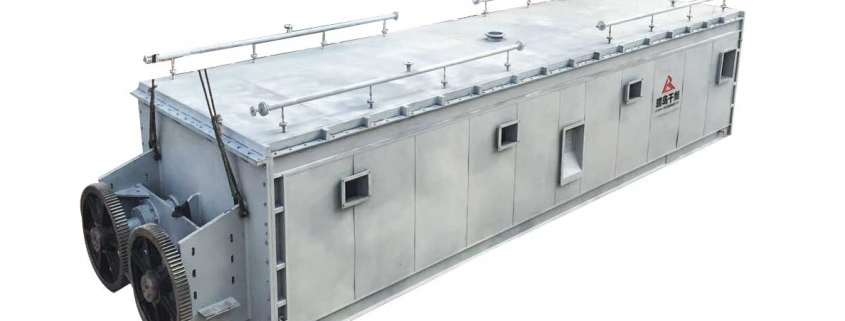What is a combined drying equipment?
Due to the different nature of various materials, drying materials in a single form of drying equipment often does not achieve the purpose of drying. If two or more drying equipments are used, they are joined together, or special equipment is added to the machine to make new In the drying process, the device has the performance of different forms of drying equipment, which can not be achieved by a single drying device, which is called a combined drying device. The combined drying may be a series connection of the same type of equipment, or a series of different types of equipment, but the materials are successively passed through different drying equipment in series, and the drying medium may pass through in series or through the drying equipment in parallel.
Combination drying is roughly:
(1) A combination of various drying methods, such as spray drying equipment;
(2) Combination of various heat transfer processes, such as film. Fluidized bed drying equipment, etc.;
(3) Combination of multi-stage drying equipment of the same type, such as multi-stage air drying equipment.
For example, a film-flow drying device is equipped with a high-speed scraper in a drying device, and the added slurry is smashed to the wall of the airflow pipe, and the outer wall of the airflow pipe is covered with a heat-insulating jacket, which will be smashed to the pipe wall. The material is dried. Due to the small distance between the scraper and the pipe wall, the dried material on the pipe wall is scraped by the impact of the airflow, and the pipe is taken out with the airflow to become the required dry material.
For another example, the spiral airflow drying device passes through the spiral pre-drying section before the material inlet flow drying device, and then is sent to the blower impeller to enter the airflow drying. This combined drying device is beneficial for reducing the moisture content of the material. When entering the blower impeller, it is easy to knead into fine powder, thus facilitating the drying process.
For another example, generally, it is stationary or simply performing a simple rotation or linear motion, and the flowability of the material is poor. If the bulk material is dried, the unevenness of the material drying will increase. We can make full use of the characteristics of the conventional dry fluidization effect to make the material evenly heated, so the advantages of the combination: short drying time (drying time is 1/4 of the time required for convection drying), high product quality, equipment integration system Compact and reduced in size, resulting in a smaller footprint and lower operating costs.
Combined drying equipment advantages
In recent years, one of the development of drying equipment direction has turned to the development of combined drying, in an effort to optimize the combination of existing drying equipment to take advantage of each drying equipment.
Advantages of combined drying compared to single stage drying:
(1) Combined drying makes it easier to save energy;
(2) Combination drying makes it easier to ensure product quality, and the drying process can be subjected to classification, pulverization, etc., and the heat sensitive material can be cooled in time after drying;
(3) The operation is more flexible, and various drying equipments can be scientifically combined according to the specific law of material drying.
Combined drying can fully utilize the characteristics of two or more drying equipment to complete a drying task. For example, the centrifugally dehydrated polyvinyl chloride resin is dried from a moisture content of 7.6% to a water content of 0.3% or less, and can be dried to a moisture content of 0.82% by a gas flow drying apparatus. If the horizontal fluidized bed drying equipment is used again, the combined moisture in the material can be removed, and the moisture content of the product can reach 0.2%, and a good effect is obtained. This is a gas-one-flow fluidized bed combined drying device.
Now, there is a trend in the combination process, that is, the use of microwave pair flow, spout, convection, and spout. The combination mode of microwave, but should consider the characteristics of various drying methods and the characteristics of materials, analyze the comprehensive factors, and determine the optimal combination process. It can be said that a reasonable combination of drying can obtain high quality products, improve the production capacity of the equipment, and obtain better economic effects.
How to treat combined drying equipment from the drying process
Most materials are dried in both constant and deceleration stages. In the constant-speed drying stage, a large amount of water is removed, and the drying rate depends on the gasification rate of the surface water of the material. The high-wind speed and large air volume are used to take the dried vaporized water vapor away from the surface of the material to improve the drying rate. In the slow-drying drying stage, the drying rate depends on the nature of the material, the mass transfer rate and the thermal driving force, and is limited by the outward migration rate of the internal moisture of the material. Increasing the hot air temperature is an important way to increase the drying rate.
Because the tail gas in the constant-speed drying stage is a low-temperature and high-humidity gas, close to saturation, it has no desiccant capacity, no drying driving force, and can no longer dry. In the slow-drying stage, the tail gas is high-temperature and low-humidity gas. How to recover this part of gas? It is used for drying at a constant speed drying stage and still functions as a drying agent. As one of the combined drying methods, the two-pole drying equipment utilizes this rule to carry out the two drying stages of the material in two drying equipments, that is, the constant-speed drying exhaust gas is discharged, and the tail gas recovery in the slow-down drying stage makes the system The discharged gas is close to saturation, thus achieving energy saving, especially for continuous drying in large quantities.



